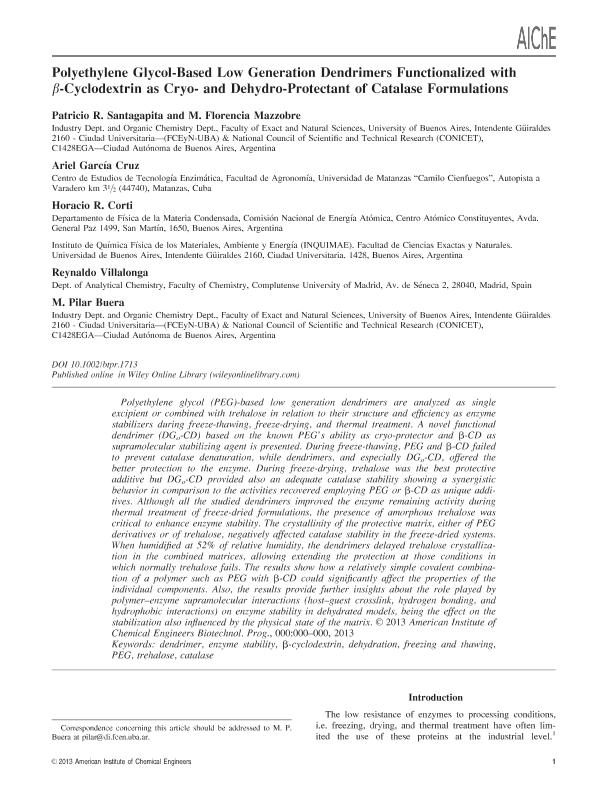Mostrar el registro sencillo del ítem
dc.contributor.author
Santagapita, Patricio Roman

dc.contributor.author
Mazzobre, Maria Florencia

dc.contributor.author
Cruz, Ariel García
dc.contributor.author
Corti, Horacio Roberto

dc.contributor.author
Villalonga, Reynaldo
dc.contributor.author
Buera, Maria del Pilar

dc.date.available
2019-06-10T18:47:17Z
dc.date.issued
2013-05
dc.identifier.citation
Santagapita, Patricio Roman; Mazzobre, Maria Florencia; Cruz, Ariel García; Corti, Horacio Roberto; Villalonga, Reynaldo; et al.; Polyethylene glycol-based low generation dendrimers functionalized with β-cyclodextrin as cryo- and dehydro-protectant of catalase formulations; American Chemical Society; Biotechnology Progress; 29; 3; 5-2013; 786-795
dc.identifier.issn
1520-6033
dc.identifier.uri
http://hdl.handle.net/11336/77869
dc.description.abstract
Polyethylene glycol (PEG)-based low generation dendrimers are analyzed as single excipient or combined with trehalose in relation to their structure and efficiency as enzyme stabilizers during freeze-thawing, freeze-drying, and thermal treatment. A novel functional dendrimer (DG o -CD) based on the known PEG's ability as cryo-protector and β-CD as supramolecular stabilizing agent is presented. During freeze-thawing, PEG and β-CD failed to prevent catalase denaturation, while dendrimers, and especially DG o -CD, offered the better protection to the enzyme. During freeze-drying, trehalose was the best protective additive but DG o -CD provided also an adequate catalase stability showing a synergistic behavior in comparison to the activities recovered employing PEG or β-CD as unique additives. Although all the studied dendrimers improved the enzyme remaining activity during thermal treatment of freeze-dried formulations, the presence of amorphous trehalose was critical to enhance enzyme stability. The crystallinity of the protective matrix, either of PEG derivatives or of trehalose, negatively affected catalase stability in the freeze-dried systems. When humidified at 52% of relative humidity, the dendrimers delayed trehalose crystallization in the combined matrices, allowing extending the protection at those conditions in which normally trehalose fails. The results show how a relatively simple covalent combination of a polymer such as PEG with β-CD could significantly affect the properties of the individual components. Also, the results provide further insights about the role played by polymer-enzyme supramolecular interactions (host-guest crosslink, hydrogen bonding, and hydrophobic interactions) on enzyme stability in dehydrated models, being the effect on the stabilization also influenced by the physical state of the matrix. © 2013 American Institute of Chemical Engineers Biotechnol. © 2013 American Institute of Chemical Engineers.
dc.format
application/pdf
dc.language.iso
eng
dc.publisher
American Chemical Society

dc.rights
info:eu-repo/semantics/openAccess
dc.rights.uri
https://creativecommons.org/licenses/by-nc-sa/2.5/ar/
dc.subject
Β-Cyclodextrin
dc.subject
Catalase
dc.subject
Dehydration
dc.subject
Dendrimer
dc.subject
Enzyme Stability
dc.subject
Freezing And Thawing, Peg
dc.subject
Trehalose
dc.subject.classification
Otras Ciencias Químicas

dc.subject.classification
Ciencias Químicas

dc.subject.classification
CIENCIAS NATURALES Y EXACTAS

dc.title
Polyethylene glycol-based low generation dendrimers functionalized with β-cyclodextrin as cryo- and dehydro-protectant of catalase formulations
dc.type
info:eu-repo/semantics/article
dc.type
info:ar-repo/semantics/artículo
dc.type
info:eu-repo/semantics/publishedVersion
dc.date.updated
2019-06-10T14:27:27Z
dc.identifier.eissn
8756-7938
dc.journal.volume
29
dc.journal.number
3
dc.journal.pagination
786-795
dc.journal.pais
Estados Unidos

dc.journal.ciudad
Hoboken
dc.description.fil
Fil: Santagapita, Patricio Roman. Consejo Nacional de Investigaciones Científicas y Técnicas; Argentina. Universidad de Buenos Aires. Facultad de Ciencias Exactas y Naturales. Departamento de Industrias; Argentina
dc.description.fil
Fil: Mazzobre, Maria Florencia. Consejo Nacional de Investigaciones Científicas y Técnicas; Argentina. Universidad de Buenos Aires. Facultad de Ciencias Exactas y Naturales. Departamento de Industrias; Argentina
dc.description.fil
Fil: Cruz, Ariel García. Universidad de Matanzas “Camilo Cienfuegos”; Cuba
dc.description.fil
Fil: Corti, Horacio Roberto. Consejo Nacional de Investigaciones Científicas y Técnicas. Oficina de Coordinación Administrativa Ciudad Universitaria. Instituto de Química, Física de los Materiales, Medioambiente y Energía. Universidad de Buenos Aires. Facultad de Ciencias Exactas y Naturales. Instituto de Química, Física de los Materiales, Medioambiente y Energía; Argentina. Comisión Nacional de Energía Atómica; Argentina
dc.description.fil
Fil: Villalonga, Reynaldo. Universidad Complutense de Madrid; España
dc.description.fil
Fil: Buera, Maria del Pilar. Consejo Nacional de Investigaciones Científicas y Técnicas; Argentina. Universidad de Buenos Aires. Facultad de Ciencias Exactas y Naturales. Departamento de Industrias; Argentina
dc.journal.title
Biotechnology Progress
dc.relation.alternativeid
info:eu-repo/semantics/altIdentifier/url/https://aiche.onlinelibrary.wiley.com/doi/abs/10.1002/btpr.1713
dc.relation.alternativeid
info:eu-repo/semantics/altIdentifier/doi/http://dx.doi.org/10.1002/btpr.1713
Archivos asociados
